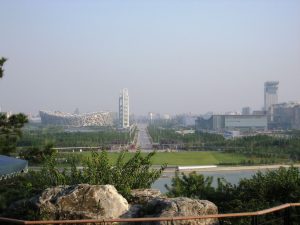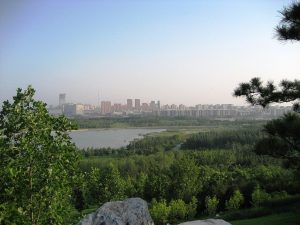
Overview of Beijing
Beijing has…
- undergone rapid urbanization in the last 30 years (Yao et al., 2014)
- population of 15.81 million people (Xu et al., 2011)
- average GDP per capita in 2005 of US$ 5,457, ranking it as one of the richest cities in China (Xie, 2011)
- 62% mountainous land coverage in the northwest

Urbanization

Green spaces in Beijing are largely in inner-city areas (Zhang et al., 2012). Despite the physical mountainous serving as geographical barriers, Beijing has more than 3,000 years of development history (Xu et al., 2011). Rapid urbanization changed the qualities of Beijing’s natural landscape. (Zhang et al., 2012).

Beijing’s urbanization is the main reason for the decline and uneven distribution of green spaces.
From urban growth in 1992 to 2004, Beijing’s urban green spaces decreased by around 47 km squared per year (Xu et al., 2011). Natural ecosystems in Beijing were gradually replaced by urban development. This negatively impacts the ecosystem services provided by green spaces (see Ecological Concerns below).
Ecological & Social Concerns
Urban green spaces create positive ecosystem service functions. These include:
- soil conservation
- atmospheric regulation
- rainfall-runoff reduction
- pollutant removal
- improved groundwater quality
- improved air quality (Mao et al., 2014; Zhang et al., 2012)
Additionally, urban green spaces have social benefits to residents such as:
- recreation
- culture
- education (Yao et al., 2014)
Therefore, rapid urbanization in Beijing equates negative environmental and social consequences. For instance, urbanization replaces native vegetation areas with hard surfaces that increase runoff (Zhang et al., 2012). Also, urban development increases the distance between citizens and natural spaces (Xu et al., 2011).

Additional Concerns

Urbanization is a major cause of Beijing’s green space decline, but not the only cause. Since the late 1990s, the Fangshan district of southwest Beijing has experienced a large decrease in green space area. This area was once grazing grassland, which has since been discarded due to soil erosion and sandstorms (Xu et al., p.460, 2011). Due to the threat of these natural processes, the once vegetated coverage has since been replaced.
There are limited land and water resources currently in Beijing. This serves as a large barrier to the possibility of developing new green spaces (Xu et al., 2011). However, the currently isolated patches of Beijing’s green space provide valuable ecosystem services, central for sustainable development in the capital city (Zhang et al., 2012).
Citations
Mao, Q., Huang, G., Buyantuev, A., Wu, J., Luo, S., & Ma, K. (2014) Spatial heterogeneity of urban soils: the case of the Beijing metropolitan region, China. Ecological Processes,23(3), 1-11. DOI:10.1186/s13717-014-0023-8
Xu, X., Duan, X., Sun, H. et al. (2011) Green space changes and planning in the capital region of China. Environmental management, 47(3), Environmental Management 47: 456-467. DOI:10.1007/s00267-011-9626-3
Xu, X. G., Cui, C. W., Xu, L. F., & Ma, L. Y. (2013). Method study on relative assessment for ecosystem service: a case of green space in Beijing, China. Environmental earth sciences, 68(7), 1913-1924. DOI: 10.1007/s12665-012-1879-5
Xie, L. (2011). China’s environmental activism in the age of globalization. Asian Politics & Policy, 3(2), 207-224. doi:10.1111/j.1943-0787.2011.01256.x
Yao, L., Liu, J., Wang, R., Yin, K., & Han, B. (2014). Effective green equivalent—a measure of public green spaces for cities. Ecological Indicators, 47, 123-127. Retrieved from http://dx.doi.org/10.1016/j.ecolind.2014.07.009
Zhang, B., Xie, G., Zhang, C., & Zhang, J. (2012). The economic benefits of rainwater-runoff reduction by urban green spaces: A case study in Beijing, China. Journal of environmental management, 100, 65-71. Retrieved from http://dx.doi.org/10.1016/j.jenvman.2012.01.015
Image Citations
Kasalukuyan (Photographer). (2005, April 4). Beijing Skyline. Retrieved from https://tl.wikipedia.org/wiki/Talaksan:Beijing_skyline.jpg
Joowwww. (Creator). (2008, August, 13). An SVG map of China with Beijing municipality highlighted [digital image]. Retrieved from https://commons.wikimedia.org/wiki/File:China_Beijing.svg
SuSanA Secretariat (Photographer). (2009, July 9). Park. Retrieved from https://www.flickr.com/photos/gtzecosan/3706213530/
SuSanA Secretariat (Photographer). (2009, July 9). View from Olympic Forest Park. Retrieved from https://www.flickr.com/photos/gtzecosan/3706211980/
gongfu_king. (Photographer). (2009, July 8). The Sun Palace Park in Beijing [digital image]. Retrieved from https://commons.wikimedia.org/wiki/File:Beijing_Sun_Palace_Park_2.jpg
ASDFGJ (Author). (2009, January 31). Fangshan District. Retrieved from https://commons.wikimedia.org/wiki/File:Fangshan.png
